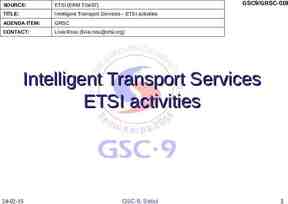2017 ETHIOPIAN POPULATION AND HOUSING CENSUS DATA CAPTURING
33 Slides664.24 KB
2017 ETHIOPIAN POPULATION AND HOUSING CENSUS DATA CAPTURING AND PROCESSING IMPLEMENTATION STRATEGY November, 2016
Outline: 1. Background 2. The Agency’s Experience in Using Digital Technology 3. Merits of Digital Enumeration 4. Factors used in Analyzing Benefits of Digital Enumeration 5. Key Issues that Need Consideration in Deciding to Implement Digital Technology 6. Data Capturing & Processing Preparatory Activities Currently Underway at the CSA 6.1 Major Activities of the Data Processing and IT Experts 7. 2017 Census Pre-tests 8. Problems Encountered during the Pre-tests 9. The 2016 Pilot Census 10. The 2017 Census Data Processing Strategy 11. Stakeholder Collaboration 12. The Way Forward
1. Background Population and Housing Census data are indispensable for effective planning and monitoring of socio-economic and demographic development policies and programs. To this end, Ethiopia has so far conducted 3 Population and Housing Censuses (PHC) in 1984, 1994, and 2007. The preparations to conduct the 2017 PHC (4 th Census) are currently underway, and one of these major undertakings is related to Census data capturing and processing. Even though census data capturing is considered to be a small part of a national census project, it is one of the most critical, costly and time consuming operations of a PHC.
Background cont . . . For instance, the data capturing process of the 1984 Ethiopian PHC took about 24 months. The 1994 PHC data entry activities took around 18 months, while the 2007 PHC data capturing process took only about 5 months. Data capturing for the 1984 and 1994 Censuses was carried out using the traditional keyboard-based data entry method. For the capture of the 2007 PHC data, the Central Statistical Agency (CSA) of Ethiopia used the Optical Mark Reader (OMR) Scanning Technology. OMR scanning technology did reduce the time taken to capture the data significantly, but it had its own drawbacks as it took a long time to resolve Enumeration Area (EA) identification mismatches.
Background cont . . . The Agency could not also benefit much from this system as it could not be used for other surveys after the Census, as there was no proper knowledge transfer. The Central Statistical Agency now, therefore, wants to take advantage of the great strides made in ICT to capture, process and produce: timely, accurate and complete census data and reports of the upcoming 2017 Population & Housing Census of Ethiopia. Accordingly, the Agency is planning to use digital devices (Tablets) to capture the 2017 Census data .
2. CSA’s Experience in Using Digital Technology The Agency has introduced handheld devices in some of its statistical operations such as: – Price data collection in 110 market places (PDAs) – Delineation of part of the EAs (30%) of the 2007 PHC using GIS-based technology – For the upcoming 2017 Census PDA-based design of EAs using ARC GIS is currently underway – Complete data collection of the 2015/16 Welfare Monitoring Survey, and Household Consumption and Expenditure Survey (Mini-laptops) – Productivity Safety Net Program Survey (Mini-laptops) – Socio-economic Surveys (Mini-laptops) – Feed the Future Survey (Mini-laptops) – 2016 Demographic and Health Survey (Mini-laptops) – Online price data collection pilot survey (Tablets) - in collaboration with ESA and UNECA
3. Merits of Digital Enumeration High savings on printing of enumeration materials, logistics, material storage, and data quality assurance validation. Relatively much less labor requirement compared to paper-based Census. Faster data collection and superior quality assurance procedures through built-in data validity checks and skip patterns. Improved data quality and timeliness i.e. faster, better, and more detailed census results can be released within a few months of the completion of enumeration. Digital enumeration facilitates the integration of data collection with GIS leading to improved field monitoring and data quality assurance checks.
Merits of Digital Enumeration cont It also provides significant opportunities for staff capacity building as the digital technology can easily be owned and adapted for use in subsequent statistical projects after the 2017 Census.
4. Factors used in Analyzing Benefits of Digital Enumeration Major factors used in analyzing benefits (direct/indirect, short/long terms) of using digital technology against the high initial costs are the following: Printing, logistics, and storage of enumeration materials Real time data quality assurance validation (built-in data validity checks and skip patterns). Extent of labor requirement (load/unload, storage, digitization of forms) Improvement in the quality of data and timeliness (faster, better census results) Possibility of integrating data collection with GIS for improved field monitoring.
Factors used in Analyzing Benefits (Digital Devices) . . Simplicity of adapting the new technology for subsequent statistical initiatives which are, among others: PES, Inter-Censal Survey 2018 Agricultural Census Newly established Vital Events Registration Agency Ministry of Health (extension workers) Ministry of Agricultural (extension workers) Possibility of sharing the devices with other African countries (through regional center of excellence) on win-win basis
5. Key Issues that need Consideration in Deciding to Undertake Digital Enumeration Acquisition of digital enumeration technology and accessories (hardware, software) requires high initial investment. Choice and procurement of technology, testing devices and systems (pre-tests, pilot tests), and personnel training require sufficient lead time. A large and well-organized warehouse to store and manage Tablets (180,000) and power banks will be required. Support infrastructure and systems must be made available: telecom, connectivity and network coverage, electricity, device maintenance. A reliable power backup system for the devices including a powerful automatic generator at the HQ (Servers) is required.
Key Issues that need Consideration cont . . . Reliable systems to secure, transfer and manage the census data should be established in time (data insecurity and loss). Linking digital maps with census enumeration system, if possible, requires time and compatibility checking. Digital enumeration-oriented technical assistances are required prior to/and during the Pilot and Main Census in the following areas: – Data capturing, transfer, security, management and processing – Network and database administration. Availing and refurbishing of census data center and processing premises.
6. Data Capturing & Processing Preparatory Activities Currently Underway at the CSA Following the decision to use digital enumeration for the 2017 Census, the CSA immediately initiated the preparatory undertakings related to data capturing and processing. As a result a Census Data Capturing and Processing Technical Working Group (TWG) was formed to carry out the preparatory activities of the digital enumeration. The TWG comprises about 25 IT and Data Processing (DP) experts from the Agency. And it was divided into 2 sub-groups, namely: The Data Capturing and Processing Team (Programers), and the Infrastructure, Device Testing and Configuration Team (IT experts).
6.1 Major Activities of the DP & IT Experts 1. Identify digital handheld devices and accessories (Tablets, Power banks . ) 2. Prepare technical specifications for the digital devices used in data collection 3. Configure, install, and test devices to ensure functionalities 4. Identify software to be used for data capturing and processing 4. Design and test data capturing applications 5. Identify, design, and test data transfer and backup mechanisms 6. Design, test, and automate data file organization mechanisms.
Major Activities of the DP & IT Experts . . . 7. Setup and prepare digital devices for pre-tests, Pilot Census and the main Census 8. Prepare power backup systems for charging mobile devices (power banks) 9. Ensure the availability of uninterrupted power backup system at the HQ during data collection 10. Prepare and load manuals for device and entry application trainings 11. Conduct trainings
7. 2017 Census Pre-tests After identifying the data capturing and processing preparatory activities, corresponding work plan was prepared to carry out the 2017 census pre-tests. Two pre-tests were carried out, the first in July 2016 and the second in early October 2016 The main objective of conducting the pre-tests has been to test the overall operations of data capturing activities, while the specific objectives are testing: – Mobile device suitability – Software suitability – Power backup systems – Network coverage – Data transfer modalities – Data security – Enumerators’ performance, accuracy of responses
2017 Census Pre-tests . . . During the fist pre-test 10 EAs in different parts of the country (6 rural, 4 urban) were selected from the ones for which cartographic work has been completed. To carry out the pre-test mobile devices available at the Agency (Tablets, Mini-laptops) were used. The purpose of using the two types of digital devices simultaneously was to identify which technology better fits the existing situations of the country. Entry application for Tablets was developed using CSPro Android, while the application for Mini-laptops was developed using the Windows version of CSPro. Following the preparation of the data capturing system a 4-day training on data entry application and digital devices was given to enumerators and technical supervisors. The data collectors and supervisors were all university graduates
2017 Census Pre-tests Both devices (Tablets, Mini-laptops) were used side by side in the same EA (by 2 enumerators) to collect data. Regarding the power backup system, once charged the battery life for Tablets lasted for about 1 day. Power banks were used to recharge the Tablets. (2 Tablets at a time) Mini-laptops were recharged through their built-in batteries. The battery life of the Mini-laptops was found to be only half a day. For the 1st pre-test, questionnaires of the 2007 census were used, as the 2017 questionnaires were not finalized by then. The data collected using Tablets were easily transferred to the FTP Server at the HQ online. (SIM card, airtime used)
2017 Census Pre-tests . . . The data collected using Mini-laptops was not transferred to the HQ online, as the transfer mechanism was not ready. The 2nd pre-test was conducted using similar procedures in 7 EAs. But it was conducted using data entry applications developed for the new 2017 Census questionnaires. For the 2nd pre-test only Tablets were used, and the collected data was transferred online. After the completion of the field work in both pre-tests, a half day evaluation of the overall operations of the census pre-tests was carried out at the HQ.
8. Problems Encountered during the Pre-Tests Network connectivity problems were encountered in some parts of the areas covered. A power interruption of about 2 days in the week of the 1st pre-test was reported in one area. Mismatches between some EA maps and corresponding descriptions were reported. Difficulty of viewing mobile devices’ screens during high sunlight was encountered and that was resolved through increasing the display light. The FTP Server was down/not accessible at times during the pr-tests mainly due to power failure.
9. The 2016 Pilot Census Duration and coverage – Two Census Pilot Surveys will be conducted instead of one (Tablet-based and Paper-based) – The first pilot census will be conducted during the last week of Nov 2016 – The second pilot is planned to be conducted in February/March 2017 and it will be only tabletbased. – During the first pilot, 260 EAs are covered, and out of these, the data for 220 EAs will be captured using Tablets, while data for the remaining 40 EAs (extreme areas) will be collected using printed questionnaires. – Extreme areas are places with no power supply and network connectivity
The 2016 Pilot Census . . . Census questionnaires and forms to be administered – HH Listing Form – Population Questionnaire – Housing Questionnaire – Summary Form
The 2016 Pilot Census . . . Devices used – Tablets – Power banks for charging Tablets
The 2016 Pilot Census . . . Trainings – Training of trainers (ToT) – Training of Enumerators and Supervisors – The trainings constitute Questionnaire contents Device use Data entry application Data quality assurance procedures – Built-in validity checks and skip patterns – Progress and completeness checks automated summary reports through
The 2016 Pilot Census . . . Summary reports (during data capturing) – Total population by sex – Age by sex – Population pyramid – Enumerator status report Data transfer Mechanism – Enumerators send collected data to the Supervisor’s Tablet through Bluetooth – The supervisor checks and transfers data online to the HQ (Server) – SIM card, Airtime provided to supervisors – The tasks of the supervisors and enumerators during data capture will be as follows
Pilot Census Data Capturing Process Supervisor Main Menu
Census Data Capturing Process . . . Enumerator Main Menu Enumerator Menu o 1 Launch Listing Form o 2 Launch Household Questionnaire o 3 Synchronize with Supervisor o 4 View Manuals o 5 Summary Reports o 6 Exit
Census Data Capturing & Transfer SERVER SUPERVISOR ENUMERATORS RAW DATA CSPRO DB MICRO DATA MONITOR
The 2016 Pilot Census . . . Paper-based pilot data entry – Keyboard data entry method will be used to capture data collected using printed questionnaires – Entry application developed using the Windows version of CSPro will be used to capture the data from the filled-in hard copy questionnaires.
10. 2017 Census Data Processing Strategy The data from the Pilot, Main Census, and subsequent PES will be processed using the Census and Survey Processing System (CSPro). CSPro is the main data processing tool at the Agency. The 2007 Census data was processed using CSPro. Other surveys conducted by the CSA are also processed using this software In general terms, the processing of the Census data (after data capture) includes: – Data file Organization – Electronic editing of the census data using the Batch Editing component of CSPro – Generating census reports using the Tabulation System of the same software. – The data in CSPro format will also be migrated to Relational Database to facilitate alternative backups, data security, integrity, monitoring & report generation purposes.
11. Stakeholder Collaboration Internal Stakeholders/Partners Information Network Security Agency (INSA) of Ethiopia Ethio Telecom Ethiopian Electric Power Agency Ministry of Information and Communication Technology Ethiopian Mapping Agency Addis Ababa University (Institute of Population Studies) External Stakeholders/Partners United Nations Population Fund (UNFPA) USAID/US Bureau of the Census UNICEF Italian Development Cooperation/ Italian National Institute of Statistics (Istat) The World bank
12. The Way Forward Data entry application for the 2017 Census questionnaires will be further reviewed and finalized The data capturing system for the Summary Form will be developed Data security and confidentiality control mechanisms will be developed and tested Census data collection is planned to be integrated with GIS to facilitate field tracking and monitoring The two phases of the 2016 Pilot Census data capturing will be conducted Procurement of Tablets and related accessories (Power banks) will be processed (about 180,000 Tablets) A warehouse for storing the Tablets will be organized The setup and cloning of the Tablets will be carried out Various census data capturing and processing staff trainings will be conducted Census data processing center will be organized
THANK YOU






































